英语第二课堂活动设计
- 格式:doc
- 大小:30.50 KB
- 文档页数:7
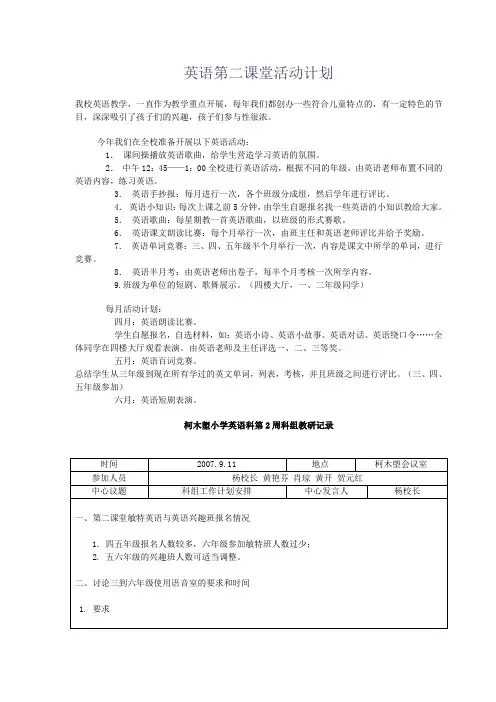
英语第二课堂活动计划
我校英语教学,一直作为教学重点开展,每年我们都创办一些符合儿童特点的,有一定特色的节目,深深吸引了孩子们的兴趣,孩子们参与性很浓。
今年我们在全校准备开展以下英语活动:
1.课间操播放英语歌曲,给学生营造学习英语的氛围。
2.中午12:45——1:00全校进行英语活动,根据不同的年级,由英语老师布置不同的英语内容,练习英语。
3.英语手抄报:每月进行一次,各个班级分成组,然后学年进行评比。
4.英语小知识:每次上课之前5分钟,由学生自愿报名找一些英语的小知识教给大家。
5.英语歌曲:每星期教一首英语歌曲,以班级的形式赛歌。
6.英语课文朗读比赛:每个月举行一次,由班主任和英语老师评比并给予奖励。
7.英语单词竞赛:三、四、五年级半个月举行一次,内容是课文中所学的单词,进行竞赛。
8.英语半月考:由英语老师出卷子,每半个月考核一次所学内容。
9.班级为单位的短剧、歌舞展示。
(四楼大厅,一、二年级同学)
每月活动计划:
四月:英语朗读比赛。
学生自愿报名,自选材料,如:英语小诗、英语小故事、英语对话、英语绕口令……全体同学在四楼大厅观看表演。
由英语老师及主任评选一、二、三等奖。
五月:英语百词竞赛。
总结学生从三年级到现在所有学过的英文单词,列表,考核,并且班级之间进行评比。
(三、四、五年级参加)
六月:英语短剧表演。
柯木塱小学英语科第2周科组教研记录。
![英语第二课堂活动计划[1]](https://uimg.taocdn.com/1a746d1ff8c75fbfc67db25c.webp)
英语第二课堂活动计划英语第二课堂活动计划英语第二课堂活动计划学语言要从娃娃抓起,小学是学习语言的关键时期,还未形成独立的语言系统,开展多方面的英语活动能够激起学生语言的兴趣,从多方面提高学生英语的综合素质,建立多方的英语环境,帮助其形成语言体系,进一步提高英语水平。
开展第二课堂活动是适应新课程改革的一大举措,是培养学生能力的重要途径。
为了全面贯彻党的教育方针,充分体现我校的办学特色和办学理念,大力推进素质教育,以第二课堂活动为契机,丰富校园课余文化生活,激发学生学习兴趣,培养学生的动手操作能力,不断提高学生的综合素质,让一小真正成为每个学生成长、进步的摇篮。
为使我校各类课外第二课堂能不断健康深入发展,为力争各级各类比赛获奖提供有力的保障,特制定本方案。
第二课堂活动实施计划开展内容(1)学唱少儿英语歌曲、英语儿歌、做英语游戏、看、听、学、讲、演英语小故事等。
(2)拟以适合本校3年级学生的各种教材,内容主要包括:学习如何利用有效时间背单词、无敌音标学习、英语口语精粹、经典英语动画欣赏、英语词汇趣谈、疯狂英语100句、如何学好英语、英语情景短剧表演,常用电话用语等等。
三年级英语第二课堂活动计划指教人:李北刘鸿雁扩展阅读:八年级英语第二课堂活动计划乌苏五中202*-202*学年第一学期第二课堂活动小组工作计划活动小组名称:初二英语备课组负责教师:马玉红小组成员所在年级:初二年级小组人数及主要成员:马玉红、贾玲、李薇、马春艳、苗霞、何桂英、朱明艳共7人一、第二课堂活动小组的指导思想:通过第二课堂活动,提高学生听、说、读、写综合能力;帮助学生扎实打好英语基础,以激发学生学习英语的兴趣,更锻炼学生能力,提高他们的综合素质。
同时也丰富了学生的课余生活,拓展学生的知识面。
二、第二课堂活动小组的活动目的及所要达到的目标:1、锻炼学生综合能力;2、激发学生学习英语积极性,提高学习英语兴趣;3、帮助学生巩固所学知识,为英语奥赛和期末考试打好基础,也提高学生成绩;4、丰富学生课余活动。
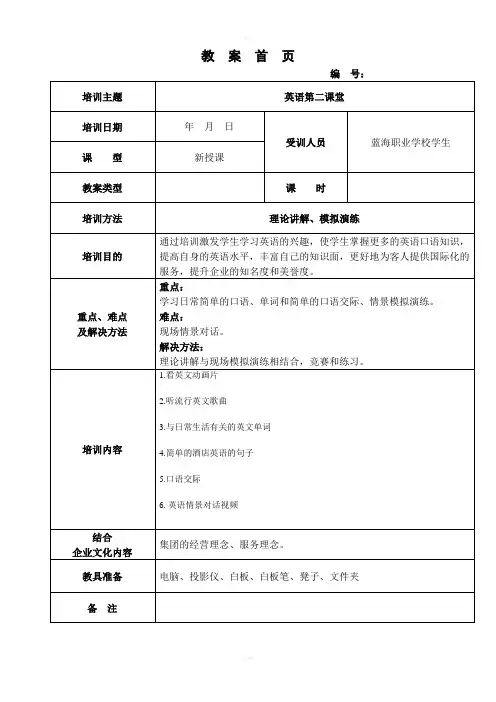
教案首页培训教案1.红茶 black tea2.绿茶 green tea3.浓(淡)茶 strong(weak)tea4.砖茶 brick tea5.(不加牛奶的)纯咖啡 black coffee6.牛奶咖啡 coffee with milk;white coffee7.速溶咖啡 instant coffee8.可可 cocoa9.牛奶 milk 10.全脂奶 whole milk 11.奶酪milk curd 12.奶粉 powdered milk 13.炼乳 condensed milk 14.麦乳精 malted milk 15.矿泉水 mineral water 16.不含酒精的饮料 soft drink 17.汽水 soda water 18.桔子水 orangeade 19.水果汁;果子露 fruit syrup 20.烈性酒 liquor;spirit 21.葡萄酒(含酒精度数较低的) wine 22.甜酒 sweet wine 23.不甜的酒 dry sweet wine 24.汽酒 bubbing wine 25.黄酒;绍兴酒 yellow wine;rice wine(Shaoxing wine) 26.白葡萄酒 white wine 27.红葡萄酒 red wine;31.香槟酒 champagne 32.白干;高梁酒 white spirit 33.白兰地 Brandy 34.苹果酒 cider 35.威士忌 whisky 39.鸡尾酒 cocktail 40.啤酒 beer 41.生啤酒draught beer 42.黑啤酒dark beer 43.雪碧sprite 主食类 staple food:三文治 sandwich米饭 rice粥 rice soup/ congee汤 soup饺子 dumpling面条 noodle比萨饼 pizza方便面 instant noodle香肠 sausage面包 bread茶叶蛋 Tea eggs饼干 cookies咸菜/泡菜 pickle馒头 steamed bread蛋糕 cake汉堡 burger火腿 ham奶酪 cheese 一对一速记单词一对一速记、看图记单词赵本山弟子的英语二人转馄饨皮 wonton skin/wonton wrapper 高筋面粉 Strong flour小麦 wheat大麦 barley青稞 highland barley高粱 broomcorn/kaoliang春卷 Spring roll芋头 Taro山药 yam鱼翅 shark fin黄花 daylily皮蛋 preserved eggs肉馅饼 minced pie糙米 Brown rice玉米 corn馅儿 stuffing开胃菜 appetizer燕麦 oat(常加牛奶作早餐用的)谷类食物 cereal 牛排 steak无骨肉片/去骨鱼片 fillet凉粉 bean jelly糯米 sticky rice燕窝 bird's nest粟 Chinese corn肉丸子 meat ball枳橙 citrange中式点心 dim sum淀粉 starch蛋挞 egg tart 竞赛学单词干果 dry fruits腰果 Cashew nuts 花生 peanut无花果 fig榛子 filbert/hazel 栗子 chestnut核桃 walnut杏仁 almond果脯 preserved fruit 芋头 taro葡萄干 raisin开心果 pistachion 巴西果 brazil nut 菱角 water chestnut酒水类 beverage红酒 red wine白酒 white wine白兰地 brandy葡萄酒 sherry汽水 soda(盐)汽水 sparkling water 果汁 juice冰棒 Ice-lolly啤酒 beer酸奶 yogurt伏特加酒 vodka鸡尾酒 cocktail豆奶 soy milk 做单词游戏接龙豆浆 soybean milk七喜 seven up凉开水 cold boiled water汉斯啤酒 Hans beer浓缩果汁 concentrated juice冰镇啤酒 iced beer/chilled beer中式早点:烧饼 Clay oven rolls油条 Fried bread stick 韭菜盒 Fried leek dumplings 水饺 Boiled dumplings蒸饺 Steamed dumplings馒头 Steamed buns割包 Steamed sandwich饭团 Rice and vegetable roll 蛋饼 Egg cakes咸鸭蛋 Salted duck egg饭类稀饭 Rice porridge白饭 Plain white rice油饭 Glutinous oil rice糯米饭 Glutinous rice卤肉饭 Braised pork rice蛋炒饭 Fried rice with egg地瓜粥 Sweet potato congee面类馄饨面 Wonton noodles刀削面 Sliced noodles麻辣面 Spicy hot noodles麻酱面 Sesame paste noodles鸭肉面 Duck with noodles鳝鱼面 Eel noodles海鲜面 Seafood noodles榨菜肉丝面 Pork , pickled mustard green noodles 牡蛎细面 Oyster thin noodles板条 Flat noodles米粉 Rice noodles炒米粉 Fried rice noodles冬粉 Green bean noodle汤类鱼丸汤 Fish ball soup贡丸汤 Meat ball soup蛋花汤 Egg & vegetable soup蛤蜊汤 Clams soup牡蛎汤 Oyster soup紫菜汤 Seaweed soup酸辣汤 Sweet & sour soup馄饨汤 Wonton soup猪肠汤 Pork intestine soup肉羹汤 Pork thick soup鱿鱼汤 Squid soup花枝羹 Squid thick soup中餐:熊掌 bear's paw海参 sea cucumber海鳝 sea sturgeon海蜇皮 salted jelly fish海带 kelp/seaweed鲍鱼 abalone鱼翅 shark fin燕窝 bird's nest考乳猪 roast suckling pig 猪脚 pig's knuckle盐水鸭 boiled salted duck 腊肉 preserved meat叉烧 barbecued pork香肠 sausage肉松 fried pork flakes烤肉 BAR-B-Q荤菜 meat diet素菜 vegetables肉羹 meat broth地方菜 local dish广东菜 Cantonese cuisine 客饭 set meal咖喱饭 curry rice炒饭 fried rice白饭 plain rice锅巴 crispy rice粥 gruel/ soft rice/porridge 打卤面 noodles with gravy 阳春面 plain noodle砂锅 casserole火锅 chafing dish/fire pot肉包子 meat bun烧麦 shao-mai腐乳 preserved bean curd/preserved tofu 豆腐 bean curd/tofu豆豉 fermented blank bean酱瓜 pickled cucumbers咸鸭蛋 salted duck egg萝卜干 dried turnip西餐与日本料理菜单 menu法国菜 French cuisine今日特餐 today's special主厨特餐 chef's special自助餐 buffet快餐 fast food招牌菜 specialty欧式西餐 continental cuisine饭前酒 aperitif炸薯条 French fires烘马铃薯 baked potato马铃薯泥 mashed potatoes简蛋卷 omelette布丁 pudding甜点 pastries泡菜 pickled vegetables韩国泡菜 kimchi蟹肉 crab meat海螺 conch田螺 escargots3. My god! 天哪!4. No way! 不行!5. Come on.来吧(赶快)6. Hold on.等一等。
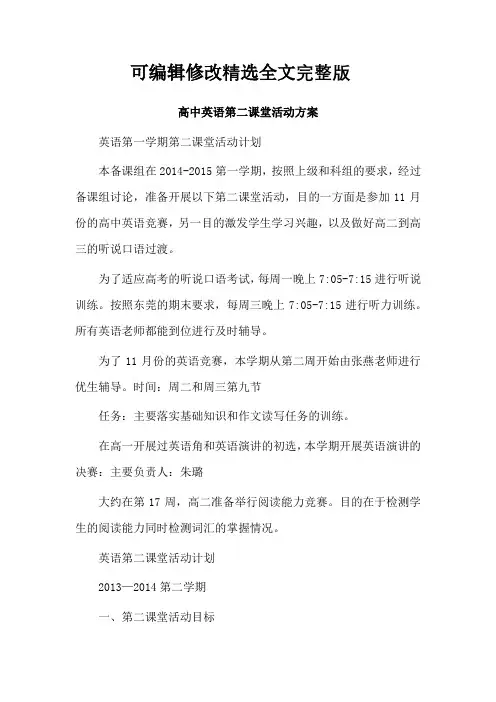
可编辑修改精选全文完整版高中英语第二课堂活动方案英语第一学期第二课堂活动计划本备课组在2014-2015第一学期,按照上级和科组的要求,经过备课组讨论,准备开展以下第二课堂活动,目的一方面是参加11月份的高中英语竞赛,另一目的激发学生学习兴趣,以及做好高二到高三的听说口语过渡。
为了适应高考的听说口语考试,每周一晚上7:05-7:15进行听说训练。
按照东莞的期末要求,每周三晚上7:05-7:15进行听力训练。
所有英语老师都能到位进行及时辅导。
为了11月份的英语竞赛,本学期从第二周开始由张燕老师进行优生辅导。
时间:周二和周三第九节任务:主要落实基础知识和作文读写任务的训练。
在高一开展过英语角和英语演讲的初选,本学期开展英语演讲的决赛:主要负责人:朱璐大约在第17周,高二准备举行阅读能力竞赛。
目的在于检测学生的阅读能力同时检测词汇的掌握情况。
英语第二课堂活动计划2013—2014第二学期一、第二课堂活动目标学语言要从小抓起,小学是学习语言的关键时期,还未形成独立的语言系统,开展多方面的英语活动能够激起学生语言的兴趣,从多方面提高学生英语的综合素质,建立多方的英语环境,帮助其形成语言体系,进一步提高英语水平。
开展第二课堂活动是适应新课程改革的一大举措,是培养学生能力的重要途径。
为了全面贯彻党的教育方针,充分体现我校的办学特色和办学理念,大力推进素质教育,以第二课堂活动为契机,丰富校园课余文化生活,激发学生学习兴趣,培养学生的动手操作能力,不断提高学生的综合素质,让学校真正成为每个学生成长、进步的摇篮。
为使我校课外第二课堂能不断健康深入发展,为力争各级各类比赛获奖提供有力的保障,特制定本方案。
二、第二课堂活动实施计划1、开展时间时间:每星期三下午第三节课,共40分钟。
2、开展内容(1)学唱少儿英语歌曲、英语儿歌、做英语游戏、看、听、学、讲、演英语小故事等。
(2)拟以PEP英语为蓝本,掺杂小部分适合本校3--6年级学生的各种教材,内容主要包括学习生活常用句型和词汇,包括问候用语、见面用语、客套用语、公共场合特定用语,常用话题等等。

最新初一英语第二课堂活动记录英语第二课堂活动记录(一)活动时间:2012.9.6活动内容:一:教学生们学做自己的名字牌步骤:1.展示给学生们我自己的名字牌。
2.让学生们观察老师的名字用英语的方式该怎样书写。
Zhou Yonghong注意:姓的第一个字母要大写;姓与名之间要有空格。
名字的第一个字母要大写。
3.学生们自己拼写自己的名字。
同学们互查是否拼写正确。
4.用准备好的材料制作名字牌。
可以在名字牌上作修饰:画画、写名言警句、格言等等。
5.在全班展示学生们的名字牌。
并让学生们相互认识。
二、从网络上欣赏字母歌曲1.欣赏;2.跟唱;3.小组表演;竞争,看看哪组唱得最好。
英语第二课堂活动记录(二)活动时间:2012.9.12活动内容:观察你身边的英语缩写字母所表示的含义,并在全班展示。
(课前先布置这个任务)步骤:1.分小组讨论你在日常生活中所注意到的英语缩略词。
并由小组长汇总。
2.每个小组由小组长在全班朗读自己小组所找出的英语缩略词。
3.其它小组补充。
看哪个小组找出的英语缩略词最多,最常用。
学生们找出了以下生活中常见的英语缩略词:HB CD BBC P NBA kg S/M/L UFO CCTV MV UN USA UK CHN KFC有学生补充:No.=number 数字WTO (World Trade Organization) 世界贸易组织BBS (Bulletin Board System) 电子布告栏系统或(Bulletin Board Service)电子布告服务GPS (Global Position System) 全球定位系统CEO (Chief Executive Officer) 首席执行官MBA (Master of Business Administration) 工商管理硕士AIDS (Acquired Immune Deficiency Syndrome ) 获得性免疫功能丧失综合症,即艾滋病CD (Compact Disc) 激光唱盘DIY (Do It Yourself)指自己动手装电脑,缝制衣服,做贺卡等DVD (Digital Video Disc) 数字化视频光盘EMS (Express Mail Service) 邮政特快专递EQ (Emotional Quotient) 情商IQ (Intelligence Quotient) 智商IT (Information Technology) 信息技术SOS国际上曾通用的紧急呼救信号,也用于一般的求救或求助VIP (Very Important Person) 重要人物RMB (renminbi)人民币MAX (maximum)最大的、的最大限度的MIN (minimum)最小的,最低限度AM=上午PM=下午春夜洛城闻笛改写本文是关于作文大全的,仅供参考,如果觉得很不错,欢迎点评和分享。

高二英语组第二课堂活动计划(2015—2016学年度第二学期)高二英语组时间: 2016.2.25高二英语组第二课堂活动计划(2015—2016学年度第二学期)为了进一步培养我校学生英语学习兴趣,提高英语学习成绩,活跃学生业余文化生活,促进校园文化建设,我校现开展第二课堂活动。
第二课堂活动是课堂教学的延伸,也是英语学科教学的有机组成部分,不仅能开阔学生视野,丰富知识,增长智慧,激发英语学习兴趣,而且有助于巩固学生课内所学知识,培养学生的创新精神和实践能力。
因此,特制订第二课堂活动计划如下:指导思想本学期以主要“培养听说读写能力”以各种形式的英语课堂活动为内容,进一步活跃校园文化生活,丰富学生课外活动,发展学生的创新思维和健康个性,促进学生素质的提高,彰显我校的英语特色,推动学校教育教学工作的开展。
二、活动目的与要求1、英语第二课堂活动要在已有的基础上常抓常新,要求各班有活动,每次有主题。
各班可根据学生实际情况,开设符合学生身心特点、更具时代气息的活动小组,丰富学生课余生活,培养学生特长,力争使每个学生在兴趣活动方面有自己的一技之长。
2、为确第二课堂小组活动的开展,本学期活动必须做到“五定”、“四性”、“五有”。
“五定”为定时间、地点、人员、辅导教师、活动内容;“四性”是指活动内容科学性、知识性、趣味性和实效性;“五有”是指各活动要有计划、有措施、有总结、有反思、有成果。
三、活动内容与形式1、英语第二课堂活动面向全体学生,由任课英语老师根据本班学生特点和实际选择合适的内容组织开展。
2、第二课堂活动小组活动主要包括:英语写作、演讲、书法、、英语朗读、英语竞赛等等。
四、保证措施1、英语二课活动纳入学校整体工作计划,任课教师负责。
2、学校对英语二课作统筹安排,宏观调控,具体部署,全面检查。
3、尽力确保英语二课设备、用品的供应。
4、适时督导,检查评比。
五、各负责人在次表安排的基础上制定各个活动的具体实施方案(活动日程、实施办法及措施、奖励办法等)。
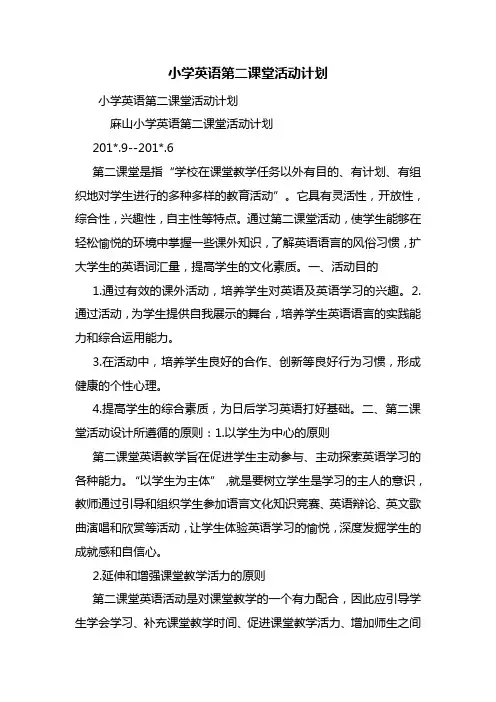
小学英语第二课堂活动计划小学英语第二课堂活动计划麻山小学英语第二课堂活动计划201*.9--201*.6第二课堂是指“学校在课堂教学任务以外有目的、有计划、有组织地对学生进行的多种多样的教育活动”。
它具有灵活性,开放性,综合性,兴趣性,自主性等特点。
通过第二课堂活动,使学生能够在轻松愉悦的环境中掌握一些课外知识,了解英语语言的风俗习惯,扩大学生的英语词汇量,提高学生的文化素质。
一、活动目的1.通过有效的课外活动,培养学生对英语及英语学习的兴趣。
2.通过活动,为学生提供自我展示的舞台,培养学生英语语言的实践能力和综合运用能力。
3.在活动中,培养学生良好的合作、创新等良好行为习惯,形成健康的个性心理。
4.提高学生的综合素质,为日后学习英语打好基础。
二、第二课堂活动设计所遵循的原则:1.以学生为中心的原则第二课堂英语教学旨在促进学生主动参与、主动探索英语学习的各种能力。
“以学生为主体”,就是要树立学生是学习的主人的意识,教师通过引导和组织学生参加语言文化知识竞赛、英语辩论、英文歌曲演唱和欣赏等活动,让学生体验英语学习的愉悦,深度发掘学生的成就感和自信心。
2.延伸和增强课堂教学活力的原则第二课堂英语活动是对课堂教学的一个有力配合,因此应引导学生学会学习、补充课堂教学时间、促进课堂教学活力、增加师生之间的亲和力等,在课堂内只能体会有限的趣味,而在第二课堂中,以学生为主体,以实践为主,以激发保持学生的兴趣为目的,更好的增强课内教学的效果,扩大词汇量,开阔视野,拓展能力。
三、第二课堂活动具体安排201*年下期周次67891011121314151617活动内容学唱英语歌谣英语会话表演学唱英语歌谣英语写作比赛学唱英语歌曲英语对话比赛英语写作展示英语词汇竞赛英语对话比赛学唱英语歌谣英语词汇竞赛英语对话比赛负责人刘运林刘运林刘运林刘运林刘运林刘运林刘运林刘运林刘运林刘运林刘运林刘运林201*年上期周次345678910111213141516活动内容学唱英语歌谣英语会话表演学唱英语歌谣英语写作比赛学唱英语歌曲英语对话比赛英语写作展示英语词汇竞赛英语对话比赛学唱英语歌谣英语词汇竞赛英语对话比赛英语词汇竞赛英语对话比赛负责人刘运林刘运林刘运林刘运林刘运林刘运林刘运林刘运林刘运林刘运林刘运林刘运林刘运林刘运林扩展阅读:小学英语第二课堂活动计划第二课堂活动计划第二课堂是指“学校在课堂教学任务以外有目的、有计划、有组织地对学生进行的多种多样的教育活动”。
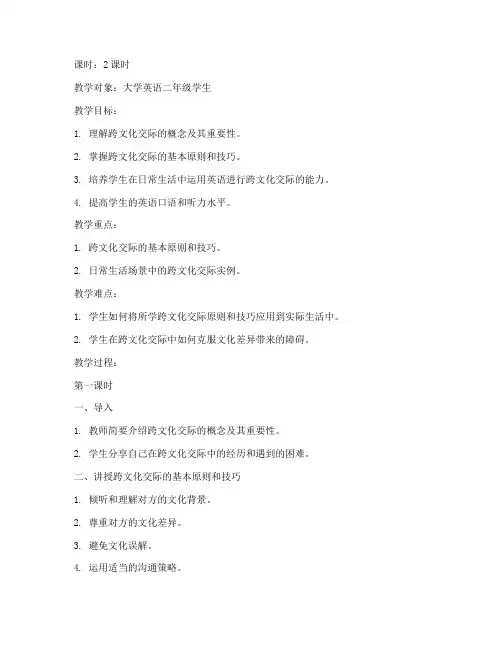
课时:2课时教学对象:大学英语二年级学生教学目标:1. 理解跨文化交际的概念及其重要性。
2. 掌握跨文化交际的基本原则和技巧。
3. 培养学生在日常生活中运用英语进行跨文化交际的能力。
4. 提高学生的英语口语和听力水平。
教学重点:1. 跨文化交际的基本原则和技巧。
2. 日常生活场景中的跨文化交际实例。
教学难点:1. 学生如何将所学跨文化交际原则和技巧应用到实际生活中。
2. 学生在跨文化交际中如何克服文化差异带来的障碍。
教学过程:第一课时一、导入1. 教师简要介绍跨文化交际的概念及其重要性。
2. 学生分享自己在跨文化交际中的经历和遇到的困难。
二、讲授跨文化交际的基本原则和技巧1. 倾听和理解对方的文化背景。
2. 尊重对方的文化差异。
3. 避免文化误解。
4. 运用适当的沟通策略。
三、案例分析1. 教师提供跨文化交际的案例,引导学生分析其中的问题和解决方法。
2. 学生分组讨论,总结案例中的跨文化交际原则和技巧。
四、实践环节1. 学生分组进行角色扮演,模拟日常生活场景中的跨文化交际。
2. 教师巡回指导,纠正学生的发音、语法和表达方式。
第二课时一、复习上节课所学内容1. 教师提问,检查学生对跨文化交际基本原则和技巧的掌握情况。
2. 学生分享自己在角色扮演中的收获和体会。
二、日常生活场景中的跨文化交际实例1. 教师列举日常生活场景中的跨文化交际实例,引导学生分析其中的文化差异和沟通策略。
2. 学生分组讨论,提出解决实际问题的方法。
三、口语练习1. 学生根据日常生活场景,用英语进行口语表达练习。
2. 教师提供反馈,帮助学生提高口语水平。
四、总结与反思1. 教师总结本节课所学内容,强调跨文化交际的重要性。
2. 学生分享自己在学习过程中的收获和体会。
教学评价:1. 学生对跨文化交际基本原则和技巧的掌握程度。
2. 学生在日常生活场景中的跨文化交际能力。
3. 学生在口语练习中的表现。
教学反思:1. 教师应关注学生的个体差异,因材施教。
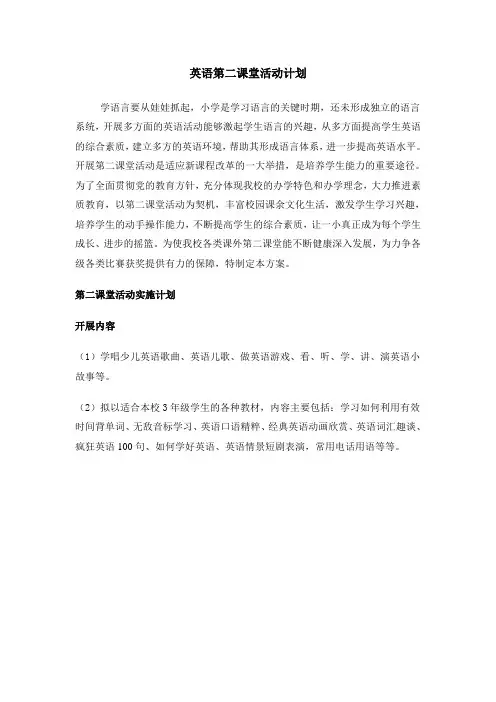
英语第二课堂活动计划
学语言要从娃娃抓起,小学是学习语言的关键时期,还未形成独立的语言系统,开展多方面的英语活动能够激起学生语言的兴趣,从多方面提高学生英语的综合素质,建立多方的英语环境,帮助其形成语言体系,进一步提高英语水平。
开展第二课堂活动是适应新课程改革的一大举措,是培养学生能力的重要途径。
为了全面贯彻党的教育方针,充分体现我校的办学特色和办学理念,大力推进素质教育,以第二课堂活动为契机,丰富校园课余文化生活,激发学生学习兴趣,培养学生的动手操作能力,不断提高学生的综合素质,让一小真正成为每个学生成长、进步的摇篮。
为使我校各类课外第二课堂能不断健康深入发展,为力争各级各类比赛获奖提供有力的保障,特制定本方案。
第二课堂活动实施计划
开展内容
(1)学唱少儿英语歌曲、英语儿歌、做英语游戏、看、听、学、讲、演英语小故事等。
(2)拟以适合本校3年级学生的各种教材,内容主要包括:学习如何利用有效时间背单词、无敌音标学习、英语口语精粹、经典英语动画欣赏、英语词汇趣谈、疯狂英语100句、如何学好英语、英语情景短剧表演,常用电话用语等等。
三年级英语第二课堂活动计划
指教人:李北
刘鸿雁。

如何设计英语第二课堂英语第二课堂是英语课堂教学必要补充,是提高学生综合能力必要前提与有力保证,是英语整体教学一个重要部分。
根据“整体决定部分,部分影响整体”这一客观规律,我们对英语第二课堂要作整体设计。
可以设计英语剧团、英语角、英语俱乐部、英语杂志与英语广播等项目。
在这个广大英语第二课堂里,学生通过参与丰富多彩、生动活泼英语活动,可以不断激发学生学习英语兴趣与自觉性,使学生在听、说、读、写、译五个方面能力得到大幅度提高。
同时,英语第二课堂也必将极大地丰富校园文化生活。
本文就英语第二课堂开展一些活动进行论述。
一、设立英语角1. 设立英语角目设立英语角,可以为全校学生提供一个在课外提高英语交际能力场所,弥补课堂教学不足,促进学生知识向技能转化。
实践证明,设立英语角以及能成功地运用英语角是检验一所学校英语教学成败重要标志。
它是一种人力、物力投入少而收效巨大活动形式。
2. 组织结构英语角主席3. 职能分工主席――全面负责英语角活动,协调主持人与公关员开展工作。
主持人――轮流参加并引导英语角活动开展,解决偶然出现各种问题。
公关员――负责在校内报道宣传英语角。
4. 操作步骤成立领导小组→确定时间与地点→自发阶段5. 注意事项(1)实行来去自由原则。
(2)不提倡限定话题或任何形式强行规定。
(3)应该让参加者感到无拘无束甚至忘记自己不是在学习而是在聊天。
(4)主持人任务在初期表现在骨干队伍组织上,而后期只是一个积极参与者,当然有偶发事件时应果敢地予以妥善处理。
教师在组织学生开展课外活动时,还应该进行课外活动基本功锻炼。
课外活动基本功锻炼形式也有多种多样,主要有:英语传话比赛、学习名言警句、唱英文歌、猜谜语、英语写作比赛、英语辩论竞赛、英语视听训练、组织学生参加竞赛活动等。
伟大教育家陶行知先生在《教学合一》中说:"与其把学生当作天津鸭儿填入一些零碎知识,不如给他们几把钥匙,使他们可以自动地去开发文化金库与宇宙之宝藏。
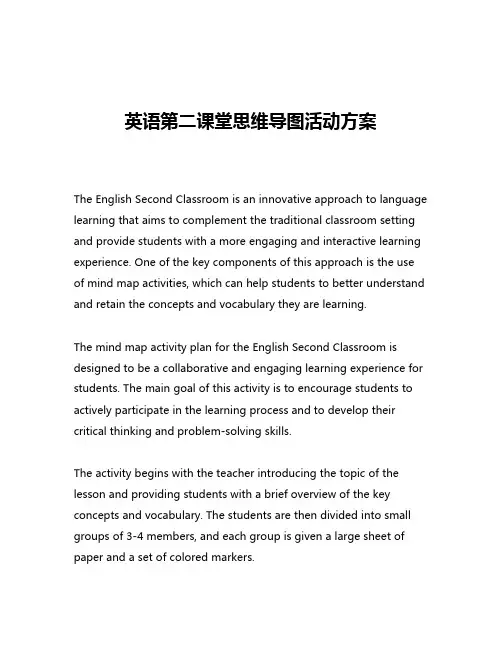
英语第二课堂思维导图活动方案The English Second Classroom is an innovative approach to language learning that aims to complement the traditional classroom setting and provide students with a more engaging and interactive learning experience. One of the key components of this approach is the use of mind map activities, which can help students to better understand and retain the concepts and vocabulary they are learning.The mind map activity plan for the English Second Classroom is designed to be a collaborative and engaging learning experience for students. The main goal of this activity is to encourage students to actively participate in the learning process and to develop their critical thinking and problem-solving skills.The activity begins with the teacher introducing the topic of the lesson and providing students with a brief overview of the key concepts and vocabulary. The students are then divided into small groups of 3-4 members, and each group is given a large sheet of paper and a set of colored markers.The students are then tasked with creating a mind map that visually represents the key concepts and vocabulary related to the topic. The mind map should include a central topic or theme, with branches or sub-topics radiating out from the center. Each branch should include relevant vocabulary, definitions, examples, and any other relevant information.As the students work on their mind maps, the teacher circulates around the classroom, providing guidance and support as needed. The teacher may also ask probing questions to encourage students to think more deeply about the topic and to make connections between the different concepts and vocabulary.Once the students have completed their mind maps, they are asked to present their work to the rest of the class. During the presentation, the students should explain the key elements of their mind map and how they are interconnected. The other students are encouraged to ask questions and provide feedback on the mind maps.One of the key benefits of the mind map activity is that it encourages students to engage in active learning. By creating their own visual representations of the topic, students are forced to think critically about the information and to make connections between different concepts and vocabulary. This helps to reinforce their understanding of the material and to improve their retention of the information.Additionally, the collaborative nature of the activity encourages students to work together and to learn from each other. As they share their ideas and insights with their group members, they are exposed to different perspectives and approaches to the topic, which can help to broaden their understanding and to develop their critical thinking skills.Another important aspect of the mind map activity is that it can be tailored to meet the specific needs and learning styles of the students. For example, the teacher can adjust the complexity of the topic or the level of the vocabulary to suit the needs of different groups of students. Additionally, the teacher can provide scaffolding or additional support for students who may be struggling with the activity.Overall, the mind map activity is a highly effective tool for enhancing the learning experience in the English Second Classroom. By encouraging students to actively engage with the material and to work collaboratively, the activity can help to improve their language skills, critical thinking abilities, and overall academic performance.。
2017 年 16 级英语实用口语第二课堂活动方案
一、授课目的
打破学生哑巴英语, 让学生敢于开口说英语; 纠正英语发音; 模
拟生活和商务情景, 提高学生情景英语的应用能力; 丰富学生的课余
生活。
二、负责讲师
李偌兰
三、学员要求
1 、对英语感兴趣;
2 、能够坚持学英语;
3 、对欧美电影有了解;
4 、想从事和英语有关的工作有或出国的意向。
三、授课时间
周一到周四下午的 16:30 分到 17:30 分
四、授课内容(课程内容)
1.自然拼读法 Phonics
2.口语的语调和略读、连读技巧
3.英语话题(一)职场自我介绍 Self-introduction
4.英语话题(二)外企的面试环节 Interview Skills
5.英语话题(三)旅行 Traveling
6.英语话题(四)航空英语 Airline English
7.英语话题(五)外企电话用语 Phone Call
8.英语话题(六)购物 Shopping
9.英语话题(七)运动 Sports
10.英语话题 (八) 健康和非健康食物 Healthy and Unhealthy Food
11.英语话题(九)交通 Transportation
五、授课方式
1.全英文授课
2.根据话题自由发表想法
2.小组模拟情景对话
3.讲师点评
4.考核
六、授课地点
F 栋教学楼 310 教室
七、参与学员(见附件)
七年级英语培优计划 刘鹏飞 张楠 樊敏 一、指导思想: 围绕提高均分、合格率和优秀率的目标,制定切实可行的培优和辅差计划,严格按计划实施,注重过程,注重效率,注重效果。提高优生的自主学习和创新能力,进一步提高中等生的学习成绩,帮助差生有所收获,让差生在教师的辅导和优生的帮助下,逐步提高学习成绩,并培养较好的学习习惯,形成基本能力。培优辅差计划要达到目的,发掘并培养一批尖子,挖掘他们的潜能,从培养能力入手,训练良好学习习惯,从而形成较扎实基础,并能协助老师进行辅差活动,以达到提高整个年级的素养和成绩。争取缩小差生范围,不拖其他课的后腿。 二、学情分析 七年级共有学生270多人,从学习情况及知识技能掌握情况看,大部分学生学习积极性高,学习目的明确,上课认真,作业能按时按量完成,且质量较好,能起到较好的模范带头作用,但也有少部分学生,基础知识薄弱,学习态度欠端正,书写较潦草,作业有时不能及时完成,还有三个学习能力有很大欠缺。因此本学期除在教学过程中要注重学生的个体差异,通过培优辅差的方式使优秀学生得到更好的发展,潜能生得到较大进步。 三、具体措施 1.认真备好每一次培优辅差的内容,努力做好学习过程的趣味性和知识性相结合。加强交流,了解潜能生、优异生的家庭、学习的具体情况,尽量排除学习上遇到的困难。 2.搞好家访工作,及时了解学生家庭情况,交流、听取建议意见。沟通思想,切实解决潜能生在学习上的困难。 3.坚持每天进行培优辅差工作。根据学生的个体差异,安排不同的作业。采用一帮一行动。 4.课堂上给每一个人创造给机会。对差生实施多做多练措施。优生适当增加题目难度,并安排课外作品阅读,不断提高做题和写作能力。 5.采用激励机制,用操行分对学生的进步实行加分,并鼓励其继续进取,调动他们的学习积极性和成功感。 6.进一步培养学生良好的学习习惯,教会学生如何去学英语。做到”堂堂清”,“月月清”:要求学生每天做好”预习—听课—复习”三步.并积极检查.把当天的功课在当天解决。在月考中检查出学生未能掌握的知识再及时把进行讲解和解决。 7.设计符合学生兴趣和认知能力的学科活动和综合实践活动 总之,本学期将充分发挥自己的潜能,在不断的实践和教学当中提升自己的水平。提高学生的成绩。 2012. 3. 1
七年级英语第二课堂活动计划I think it's important to have a variety of extracurricular activities planned for the seventh grade English class. These activities can help students engage with the language in a fun and interactive way. 我认为为七年级英语课程安排各种课外活动是很重要的。
这些活动可以帮助学生以有趣和互动的方式参与到语言学习中。
One way to incorporate more interactive activities into the class is to have students participate in role-playing exercises. This can help them practice their English speaking skills in a more realistic setting. 一个增加互动活动的方法是让学生参与角色扮演练习。
这可以帮助他们在更贴近实际场景的环境中练习英语口语技能。
In addition to role-playing, it could be beneficial to organize group projects where students can work together to create presentations or skits in English. This can help them practice collaborating with their peers while also improving their language skills. 除了角色扮演,组织学生进行小组项目也是有益的,他们可以一起创作英语演讲或小品。
英语第二课堂听写活动方案In the modern education landscape where the emphasis on language proficiency is ever-increasing, the concept of the "second classroom" has gained significant traction as a supplementary learning environment to enhance students' English language skills. The second classroom, distinct from the traditional classroom setting, offers a dynamic and interactive platform for students to engage in language-focused activities that complement their formal curriculum. One such activity that has proven to be highly effective in the second classroom is the English dictation exercise.The English dictation activity is a powerful tool that can significantly contribute to the development of students' listening comprehension, spelling accuracy, and overall language proficiency. By actively engaging in the process of listening, processing, and transcribing spoken English, students are able to hone their language skills in a structured and focused manner. This activity not only reinforces the connection between the spoken and written forms of the language but also encourages students to pay close attention to pronunciation, intonation, and the nuances of the English language.When designing an effective English dictation activity plan for the second classroom, it is crucial to consider several key elements that will ensure the activity's success and maximize its impact on student learning.Firstly, the selection of appropriate content for the dictation exercise is of paramount importance. The content should be carefully curated to align with the students' current level of English proficiency and the learning objectives of the broader curriculum. This may involve choosing passages from textbooks, news articles, or other authentic sources that are relevant and engaging for the target audience. Additionally, the length and complexity of the selected content should be tailored to the students' abilities, gradually increasing in difficulty as their skills progress.Secondly, the delivery of the dictation exercise must be structured in a way that supports student learning and encourages active engagement. This may involve providing students with pre-listening activities, such as vocabulary previews or contextual discussions, to prepare them for the content they will encounter. During the dictation itself, the instructor should read the passage at a pace that is clear and comprehensible, potentially pausing at strategic points to allow students to transcribe the content. Furthermore, the instructor should be mindful of their enunciation, pronunciation, andany necessary repetitions to ensure that students can accurately capture the spoken material.Thirdly, the assessment and feedback mechanisms employed in the English dictation activity are crucial for fostering student growth and improving their language skills. After the dictation exercise, students should be given the opportunity to review their work and identify areas for improvement. This can be facilitated through peer-to-peer review, where students exchange their transcripts and provide constructive feedback to one another. Alternatively, the instructor can lead a group discussion, highlighting common errors or areas of strength, and guiding students on how to address their weaknesses.In addition to the individual feedback, the instructor should also consider implementing a comprehensive grading system that takes into account various aspects of the dictation exercise, such as accuracy, spelling, grammar, and overall comprehension. By providing detailed and meaningful feedback, students can gain valuable insights into their language proficiency and develop strategies for continuous improvement.Furthermore, the English dictation activity should be integrated into a broader framework of language learning activities within the second classroom. This may involve incorporating complementary exercises, such as vocabulary building, grammar practice, or oralpresentations, to create a well-rounded and cohesive learning experience. By leveraging the synergies between these activities, students can develop a more holistic understanding of the English language and its practical applications.To ensure the long-term success and sustainability of the English dictation activity in the second classroom, it is essential to establish a structured and consistent implementation plan. This may involve scheduling regular dictation sessions, maintaining a database of content for future use, and providing ongoing professional development opportunities for instructors to refine their facilitation skills.Moreover, the integration of technology can significantly enhance the efficiency and engagement of the English dictation activity. Digital tools, such as audio recording software, online dictation platforms, and collaborative editing software, can streamline the process, facilitate real-time feedback, and foster a more interactive learning environment.In conclusion, the English dictation activity is a powerful and versatile tool that can significantly contribute to the development of students' English language proficiency within the second classroom setting. By carefully designing and implementing a comprehensive activity plan, educators can create a dynamic and engaging learning experiencethat not only improves students' listening comprehension and spelling accuracy but also fosters a deeper appreciation and understanding of the English language as a whole. As the demand for language proficiency continues to grow, the strategic integration of the English dictation activity into the second classroom can serve as a valuable asset in preparing students for success in an increasingly globalized world.。
罗陂中学2016-2017年第二学期
英语第二课堂
活
动
记
录
英语教研组
活动方案:
一、活动目的
为了丰富学生的第二课堂,提高学生学习英语的兴趣,七年级英语备课组的教师和级的全体教师组织七年级的学生参加丰富多彩的校园英语活动。
二、活动内容
英语猜谜语,字谜,智力选择题,字母代码游戏。
三、参与对象
初一级全体学生
四、活动安排
1、准备阶段
(1)老师上网准备一些英语猜谜语,字谜,智力选择题,字母代码游戏的资料。
(2)老师把准备好的资料打印好,题目要200题左右,把每一题剪出来,准备一些包装带,把每题粘在包装带上,在操场上找一个挂起这些题目。
2、游戏规则
(1)每位学生可以看你喜欢的题目,但不能马上把题目拿下来,当你确定答
案后,才可以小心拿下题目到英语老师那儿对答案。
答对了将得到一份
小礼物。
答错了,要把题目挂回原来的地方,继续参与。
(2)答对的题目,老师将把它回收,每题一次机会。
(3)扰乱秩序的同学将严肃处理,并且在德育考核上扣5分。
3、实施阶段
(1)学生在第七节下课后,进行活动。
(2)学生确定答案后,可以到指导教师彭之凝,刘妍妍,刘小成,老师那儿对答案,拿小礼物。
(3)陈小芳彭建生黄欢欢老师维持纪律。
活动记录
活动评价:
英语活动课能培养学生的竞争意识、创新精神和组织能力。
原苏联教育家苏霍姆林斯基将活动作为“个性发展的一个重要条件”,并认为“只有当孩子每天按自己的愿望随意使用5—7个小时的空余时间,才有可能培养出聪明的、全
面发展的人来。
”英语活动课的全过程由学生设计、学生组织、学生管理、学生总结评价。
在活动中,英语学科课程成绩好的学生可以别出心裁地安排、组织活动,起表率作用;英语学科课程成绩不好的学生可以消除“差生”的心理包袱,克服自卑心理,以积极的态度去思索、组织安排每次的英语活动课。
通过活动,学生的创新精神、组织能力可以得到很好的培养。